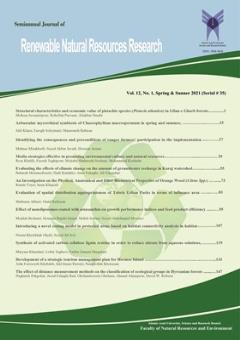Application of Machine Learning Methods for Modeling Steam Import Reduction aimed at Energy Resources Management
Ehsan Sharifara 1 , Madjid Abbaspour 2 * , Alireza saraei 3
1 - Ph.D. Candidate in Energy Systems Engineering, Faculty of Natural Resources and Environment, Science and Research Branch, Islamic Azad University, Tehran, Iran
2 - Professor at School of Mechanical Engineering, Sharif University of Technology, Tehran, Iran
3 - Assistant Professor at Department of Mechanical Engineering, Islamic Azad University, South Tehran Branch, Tehran, Iran
Keywords: Energy conservation opportunity, Energy modeling, Machine learning, Steam consumption prediction.,
Abstract :
Integrated Ethylene Oxide/Ethylene Glycol (EO/EG) plants are major energy consumers, particularly in High-Pressure Steam (HPS) usage. This study proposes a data processing and modeling framework for high-accuracy machine learning modeling to predict the HPS import of an EO/EG petrochemical plant. The study employed Python3 and analyzed raw historical data from the plant's DCS, spanning five years of operation under the same EO catalyst. Daily feed and glycol production data were used to calculate catalyst selectivity and the plant's production capacity as models’ input features, while HPS import served as the models’ output target. Various regression algorithms were evaluated to select the best model for this case study, with their hyperparameters tuned using Grid Search and Bayesian Search algorithms. Random forest regression outperformed other methods in R2, MAPE, and RMSE metrics but had the longest training time. Polynomial ridge regression was a suitable choice considering both time consumption and performance. The tuned random forest regression model revealed an approximate 291 Tonne/Day potential for HPS import savings equivalent to 16% of the plant’s average HPS import through enhanced steam import management strategies. Adopting this HPS saving measure would enable the HPS supplier to avert 38 tonnes of CO2 emissions daily equivalent to 0.37% of its nominal HPS generation capacity. Our methodology in this paper can be applied to other EO/EG plants and is currently being integrated into the plant's energy management system, enabling continuous monitoring of steam import behavior relative to catalyst and plant performance.
Ahmadi, A., Noorpoor, A. R., Kani, A. R., Saraei, A. (2021) Modeling and Economic Analysis of MED-TVC Desalination with Allam Power Plant Cycle in Kish Island. Iran. J. Chem. Chem. Eng, 40(6), 1882.
Hauke, J., Kossowski, T. (2011) Comparison of values of Pearson's and Spearman's correlation coefficients on the same sets of data. Quaestiones geographicae, Jun 24;30(2):87-93.
James, G.M., Witten, D., Hastie, T., Tibshirani, R. (2013) An Introduction to Statistical Learning, Page 181.
Mhlanga, D. (2021) Artificial Intelligence in the Industry 4.0, and Its Impact on Poverty, Innovation, Infrastructure Development, and the Sustainable Development Goals: Lessons from Emerging Economies?, Sustainability, vol. 13, no. 5788, pp. 1–16.
Moghadasi, M., Izadyar, N., Moghadasi, M., Ghadamian, H. (2021) Applying machine learning techniques to implement the technical requirements of energy management systems in accordance with ISO 50001: 2018, an industrial case study. Energy Sources, Part A: Recovery, Utilization, and Environmental Effects, Dec 20:1-8.
Moghadasi, M., Ozgoli, H.A., Farhani, F. (2021) Steam consumption prediction of a gas sweetening process with methyldiethanolamine solvent using machine learning approaches. International Journal of Energy Research, Jan;45(1):879-93.
Qian, Y.Y. , Chen, R.L., Chen, J.J., Ding, G.R. (2016) Analysis of the Production and Market of Ethylene Oxide in China. Chem. Ind., 34(2), 46-48.
Rahimpour, M. R., Shayanmehr, M., Nazari, M. (2011) Modeling and Simulation of an Industrial Ethylene Oxide (EO) Reactor Using Artificial Neural Networks (ANN). Industrial & Engineering Chemistry Research, 50(10), 6044-6052.
Sharifara, E. Abbaspour, M., Saraei, A. (2023) Analysis of the high-pressure steam import behaviour of an integrated ethylene oxide/ethylene glycol petrochemical plant under different production scenarios. Canadian Journal of Chemical Engineering. 2023,1. https://doi.org/10.1002/cjce.25143
Shell International Chemicals, Shell Research and Technology Centre Amsterdam, EO/EG Process and Site Support, EO/EG Process Design Package.
Statista. (2023) Retrieved from Statista: https://www.statista.com/statistics/1245260/ethylene-oxide-market-volume-worldwide/.
Zahedi, G. Lohi, A. Mahdi, K. A. (2011) Hybrid Modeling of Ethylene to Ethylene Oxide Heterogeneous Reactor. Fuel Processing Technology, 92(9), 1725-1732.
Zapf, F., Wallek, T. (2022) Case-study of a flowsheet simulation using deep-learning process models for multi-objective optimization of petrochemical production plants. Computers & Chemical Engineering, 162: 107823.
Zendehboudi, S., Rezaei, N., Lohi, A. (2018) Applications of hybrid models in chemical, petroleum, and energy systems: A systematic review. Applied energy, 228: 2539-2566.
Zendehboudi, S., Zahedi, G., Bahadori, A., Lohi, A., Elkamel, A., Chatzis, I. (2014) A dual approach for modelling and optimisation of industrial urea reactor: Smart technique and grey box model. The Canadian Journal of Chemical Engineering, 92.3: 469-485.

